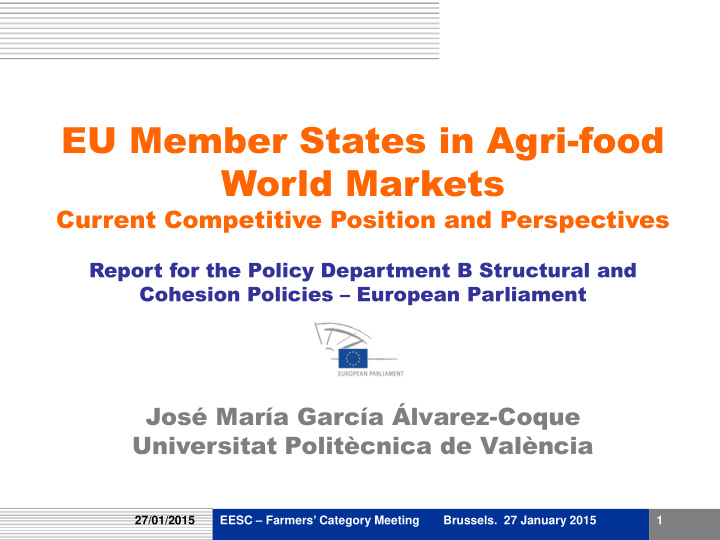



EU Member States in Agri-food World Markets Current Competitive Position and Perspectives Report for the Policy Department B Structural and Cohesion Policies – European Parliament José María García Álvarez-Coque Universitat Politècnica de València EESC – Farmers ’ Category Meeting Brussels. 27 January 2015 27/01/2015 1
Stru Structure of the P cture of the Presen resentation tation 1. Bakground 2. Trade Performance 3. Prospective survey 4. Competitiveness factors 5. Case studies 6. Conclusions and recommendatios 27/01/2015 2
1. B 1. Back ackgroun ground The EU, a leading agri-food actor: 87% exports are added value products. But elements of fragility persist. A group of experts • JM. Garcia, M. Petit, Z. Kristová, T. Heckelei, K. Arovuori, P. Pyykkönen , Fabian Capitanio, Raúl Compés-López, Victor Martínez-Gómez. Examined the EU competitiveness in world markets. Assessed the scope and influence of policies. 27/01/2015 3
Competitiveness refers to “ ability of firms or nations to offer quality products at competitive prices and to provide adequate returns on the resources employed ” 27/01/2015 4
Export� performance� view Productivity� view � � (Zero-sum� game) (Positive-sum� game) Short-term� approach� Long-term� approach� RDi� � Non� Cost/Price� Cost/Price Competitiveness Competitivenes s Scale� Quality� � � � � Technology� � � Brand� Specialisation� � � � � Origin� Capital� Proximity� Integration/ Trade� Tradition� Consolidation� � 27/01/2015 5
Method Methods Standard indicators of trade performance A prospective online survey targeting a large group of stakeholders and complemented with in-depth interviews. 158 respondents 19 Member States Research (34 %), farming organisations (28 %), public officers (18 %) processors (15 %), inter- professional organisations (5 %), retailers (4 %) and wholesalers (4 %). Case studies following a food chain approach 27/01/2015 6
2. T 2. Trade ade perf perfor ormance mance Export market share (EMS) and Net Export Indicator (NEI) � Source: Comext, WITS, authors 27/01/2015 7
A quite diverse picture in the EU-28. Since 2002…. Better performance in Baltic States, Luxembourg, Poland, Portugal and Romania. Greatest declines in Denmark, Hungary and Slovenia. Sector performance: Better performance in meat ( pork ), fruit and vegetables , cereals . Less optimistic in milling industry, oilseeds , sugar and fats and oils . In milk and dairy, competitiveness of the EU-28 has been deteriorating over time. EU: world ’ s leader in drinks . Wine exports recovering. 27/01/2015 8
3. Prospec 3. Pros pective surve tive survey Optimistic views……… Quality and growth potential of the EU agri-food economy. Less optimistic views… Weak ability of the EU agri-food sector to increase employment. Trade balance will be negative in significant sectors. Foreign demand is only part of the solution. Performance is expected to improve in Sectors that have been most affected by the crisis. Export-oriented Mediterranean sectors Grain exports . 27/01/2015 9
4. C 4. Competitiven ompetitiveness ess fa factors ctors Agricultural productivity gap Weak farm structures Limited scope for crop yield increase Coordination in the value chain Producer Organisations ’ limited negotiating power. Need for strengthening management capacities in POs. Possible conflict between competition rules and POs Innovation Recent EU policy focus on the innovation potential of the agri-food sector. Faster knowledge exchange is needed. 27/01/2015 10
Labour productivity gap between the US and the EU-15 � Source: KLEMS Database, 2014 27/01/2015 11
Cereal yields in 2012 � Source: FAOSTAT 27/01/2015 12
Annual Agricultural Total Factor Productivity growth (%) Source: USDA (2014) 27/01/2015 13
Agricultural R D expenditure (EUR million) � Source: OECD (2014), Eurostat (2014) 27/01/2015 14
5. Case 5. C ase s studies tudies Competitiveness issues Cereals: rising demand and price volatility Dairy products: increasing demand and market power. Beef: low profitability, Mercosur challenge Fruit and vegetables: market power, operational programmes, crises prevention. Olive oil: demand in no traditional markets, standard harmonisation. Wine: Competition between “ old ” and “ new ” worlds, regulatory burden. 27/01/2015 15
Th The e role of policies role of policies Pilar I Impact of direct payments on productivity is ambiguous. Pilar II Great potential to promote sustainability, competitiveness and innovation. 2014-2020 budget raises concerns on policy effectiveness. Trade policies Significant impact on chain performance. Bilateral agreements, a practical road-map. Risk that the TTIP will shift standards towards the ‘ least common denominator ’ . Sustainability and climate challenges raise innovation opportunities rather than threats . 27/01/2015 16
6. C 6. Conc onclusions a lusions and reco nd recommend mmendations ations Fair performance but not balanced within the EU. A challenge for the single market. Need for effective and non-burdensome regulations. Social, territorial cohesion and sustainability should contribute to agri-food competitiveness. Attention to domestic market! Trade policy, a strategy to level the playing field in the world setting. Keep EU leadership in WTO: TRIP. Pillar II, lost opportunity? New R&D&I partnerships open opportunities for public and private stakeholders. 27/01/2015 17
EU Member States in Agri-food World Markets Current Competitive Position and Perspectives José María García Álvarez-Coque Universitat Politècnica de València EESC – Farmers ’ Category Meeting Brussels. 27 January 2015 27/01/2015 18
Recommend
More recommend